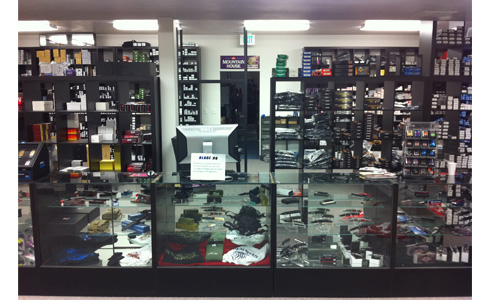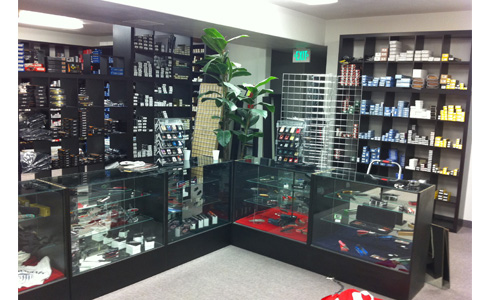The year was 2003. We had been running BladePlay for a few months and we wanted to get into some higher end cutlery. Our first two picks were Benchmade and Kershaw. We called them both and one of their first questions was, “Do you have a physical store?” We didn’t, and so our efforts were temporarily stonewalled. Later that year we moved from my home into our first warehouse in Orem, UT.
One of the first phone calls from the warehouse was to Benchmade. “Yes, we have a store.” The warehouse was 900 square feet, about 100 of which was a small front office. That office was “the store.” Benchmade sales were brisk and things were going well. And then one day our Benchmade rep, Campbell, called us. “Hey! I’m about fifteen minutes from your store.”
Fate was on our side that day. We had a customer in the warehouse at that very moment (Vaughn). With his help we literally carried the warehouse shelving into the front office and set up a “store.” We threw a desk in the corner and Jim manned the phone. “Browse!” I commanded Vaughn as Campbell pulled up. As I opened the door to welcome Campbell the phone rang and Jim took the call. Campbell eyed our setup with warranted suspicion. There was a tense moment and then he finally shrugged. The store was good enough.
So why a store? Lost of brand name companies require that you have a physical (brick and mortar) store in order to carry their product line. Campbell explained that, in Benchmade’s case, it was a mechanism to ensure brand integrity. Benchmade doesn’t want people selling their knives out of a garage. Additionally, if you have a store it gives you a certain credibility. I can certainly see that angle. As an established knife retailer I’ve actually come to appreciate this requirement. It’s a barrier to entry. One layer of protection for those of us in the business already. But the walls are coming down.
Not all brands care if you have a store. Many are readily available through distribution networks or from the manufacturer directly. And with Internet shopping become such a dominant force many companies that “require” a storefront don’t really check anymore. Part of me wishes they would. I enjoy an equal playing field. A guy selling out of this garage doesn’t have the overhead of a guy who runs a full on store (my overhead is nearly $4000 a day). Still, despite the drawbacks of a store, they are really cool. Which brings me to our new store.

We moved to our current location last July (2009- you can see the store we threw together here if you’d like). It wasn’t until this past week week (November 2010) that we decided to finally get things finished up. A store gives you power. It gives you legitimacy. It gives you bragging rights. It’s a lot of work, but I really think when we’re finished it’s going to be beautiful. The design came together pretty well. Once it’s finished I’ll be sure to post more pictures (some before and after).

I was reading “Delivering Happiness” the other day. I smiled when Tony was explaining how shoe manufactures required companies to have a physical store. Zappos ended up buying a local shoe business so they could carry the brands they needed. Our store has been a great tool. But when we allowed it to fall into disrepair it didn’t seem to matter (except to our egos). Maybe we’ve outgrown the need for a store (our brand has become reasonably well respected), but we’re going to have one! Stay tuned.
